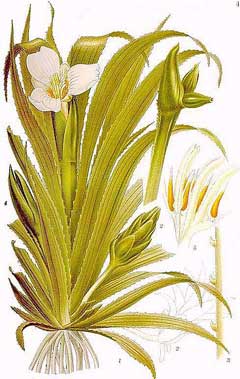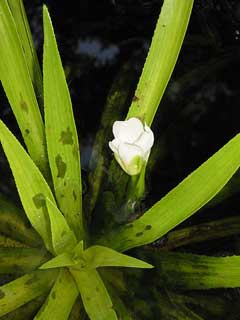 |
|
http://commons.wikimedia.org/wiki/File:481_Stratiotes_aloides.jpg |
 |
| http://commons.wikimedia.org/wiki/User:Meneerke_bloem |
Translate this page:
Summary
Noxious Weed Information:
Stratiotes aloides.
This plant is listed by the U.S. federal government or a state.
Alabama: water-aloe Class C noxious weed
Florida:
water-aloe, soldier plant. Prohibited aquatic plant, Class 1
Physical Characteristics

 Stratiotes aloides is a PERENNIAL growing to 1 m (3ft 3in) by 1 m (3ft 3in).
Stratiotes aloides is a PERENNIAL growing to 1 m (3ft 3in) by 1 m (3ft 3in).
See above for USDA hardiness. It is hardy to UK zone 5. It is in flower from June to August. The species is hermaphrodite (has both male and female organs).
Suitable for: light (sandy), medium (loamy) and heavy (clay) soils. Suitable pH: mildly acid, neutral and basic (mildly alkaline) soils. It can grow in semi-shade (light woodland) or no shade. It prefers moist soil.
UK Hardiness Map
US Hardiness Map
Synonyms
Plant Habitats
Pond; Bog Garden;
Edible Uses
References More on Edible Uses
Medicinal Uses
Plants For A Future can not take any responsibility for any adverse effects from the use of plants. Always seek advice from a professional before using a plant medicinally.
The herb has had a high reputation for treating wounds, especially when these are made by an iron implement. It is applied externally[4]. The plant is also said to be of use in the treatment of St. Anthony's Fire and also of bruised kidneys[4].
References More on Medicinal Uses
The Bookshop: Edible Plant Books
Our Latest books on Perennial Plants For Food Forests and Permaculture Gardens in paperback or digital formats.

Edible Tropical Plants
Food Forest Plants for Hotter Conditions: 250+ Plants For Tropical Food Forests & Permaculture Gardens.
More

Edible Temperate Plants
Plants for Your Food Forest: 500 Plants for Temperate Food Forests & Permaculture Gardens.
More

More Books
PFAF have eight books available in paperback and digital formats. Browse the shop for more information.
Shop Now
Other Uses
References More on Other Uses
Cultivation details
A water plant, it requires a neutral to alkaline water[200]. The herb is submerged at most times of the year, rising to the surface only when it is flowering[17]. The leaves accumulate calcium carbonate and by the autumn this makes them heavy enough to sink to the bottom of the pond. The new leaves in spring do not have this calcium carbonate and so rise to the surface[200]. A vigorous-growing plant, it will tend to swamp out other plants when grown in a small pond[200]. Plants are dioecious, male and female plants must be grown if seed is required[17]. Only the female plant occurs naturally in Britain, though plants with hermaphrodite flowers are also found occasionally[17]. Seed is never set in Britain, the plants increasing mainly by offsets[17].
References Carbon Farming Information and Carbon Sequestration Information
Temperature Converter
Type a value in the Celsius field to convert the value to Fahrenheit:
Fahrenheit:
The PFAF Bookshop
Plants For A Future have a number of books available in paperback and digital form. Book titles include Edible Plants, Edible Perennials, Edible Trees,Edible Shrubs, Woodland Gardening, and Temperate Food Forest Plants. Our new book is Food Forest Plants For Hotter Conditions (Tropical and Sub-Tropical).
Shop Now
Plant Propagation
Seed - best sown in situ as soon as it is ripe. The seed is seldom if ever produced in Britain[17]. Division at almost any time of the year, though spring is best.
Other Names
If available other names are mentioned here
Native Range
TEMPERATE ASIA: Turkey, Russian Federation-Ciscaucasia (Ciscaucasia), Russian Federation-Western Siberia (Western Siberia) EUROPE: Denmark, Finland, United Kingdom, Sweden (south), Austria, Belgium, Czech Republic, Germany, Hungary, Netherlands, Poland, Slovakia, Russian Federation (European part), Belarus, Estonia, Lithuania, Latvia, Moldova, Russian Federation (Saratov, Volgogradskaja oblast), Ukraine, Albania, Bulgaria, Bosnia and Herzegovina, Croatia, Italy, Romania, Serbia, Slovenia, Spain
Weed Potential
Right plant wrong place. We are currently updating this section.
Please note that a plant may be invasive in one area but may not in your area so it's worth checking.
Conservation Status
IUCN Red List of Threatened Plants Status :

Growth: S = slow M = medium F = fast. Soil: L = light (sandy) M = medium H = heavy (clay). pH: A = acid N = neutral B = basic (alkaline). Shade: F = full shade S = semi-shade N = no shade. Moisture: D = dry M = Moist We = wet Wa = water.
Now available:
Food Forest Plants for Mediterranean Conditions
350+ Perennial Plants For Mediterranean and Drier Food Forests and Permaculture Gardens.
[Paperback and eBook]
This is the third in Plants For A Future's series of plant guides for food forests tailored to
specific climate zones. Following volumes on temperate and tropical ecosystems, this book focuses
on species suited to Mediterranean conditions—regions with hot, dry summers and cool, wet winters,
often facing the added challenge of climate change.
Read More
Expert comment
Author
L.
Botanical References
17
Links / References
For a list of references used on this page please go here
Readers comment